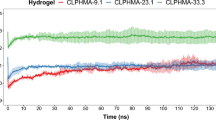Abstract
PAAm–MC hydrogels as a potential delivery vehicle for the controlled release of paraquat pesticide was investigated, as they play an essential role to use hydrogels in controlled release technology. The release kinetics of paraquat was determined using UV–Vis measurements. The release mechanism of paraquat from PAAm–MC hydrogels was investigated through a semi-empirical model proposed by Ritger and Peppas. In general, the initial rate of paraquat release was fast, decreasing after several days, hence indicating that paraquat on the surface (or close to) of hydrogels diffused rapidly after the initial swelling of the gel. Later, the cumulative release occurred in a very controlled and sustained manner, with the paraquat concentration maintaining constant from 15 to 46 days. The paraquat release capacity was dependent on the swelling of the matrix and the density of the network chains. The curves obtained from Peppas’s model presented good linearity (R 2 ≥ 0.999), indicating that such model can be applicable to analyze the systems. The n values for the pesticide release from hydrogels indicate that paraquat release has Fickian and non-Fickian diffusion, depending of hydrogel formulation. The values of k showed that the release of paraquat becomes slower when the MC and AAm concentration increases. Finally, to the best of our knowledge, we report a hydrogel-based vehicle (first carrier) that is able to prolong the sustained release of paraquat pesticide up to 45 days, which is essential for its application in controlled release systems.







Similar content being viewed by others
Abbreviations
- π:
-
Osmotic pressure defined by Donnan equilibrium theory
- μ :
-
Chemical potential
- AAm:
-
Acrylamide
- Abs:
-
Absorbance
- C :
-
Mobile ion concentration
- C R :
-
Cumulative release
- G :
-
Gibb’s free energy
- k :
-
Constant incorporating structural and geometric characteristics of the macromolecular polymeric system and the pesticide
- M ∞ :
-
Amount of paraquat loaded onto the hydrogel
- MBAAm:
-
N,N′-methylene-bis-acrylamide
- MC:
-
Methylcellulose
- M t :
-
Cumulative amount of paraquat released at time “t”
- n :
-
Release exponent representing the release mechanism
- P :
-
Pressure
- PAAm:
-
Polyacrylamide
- q eq :
-
Maximum paraquat adsorption
- R :
-
Universal gas constant
- R 2 :
-
Linear regression coefficient
- SD:
-
Standard deviation
- SEM:
-
Scanning electron microscopy
- T :
-
Absolute temperature
- TEMED:
-
N,N,N′,N′-tetramethylethylene-diamine
- UV–Vis:
-
Ultraviolet–visible
- V :
-
Volume
- wt%:
-
Weight percent or mass percent
References
Işıklan N (2007) J Appl Polym Sci 105:718
Lee WF, Lin YH (2006) J Mater Sci 41:7333. doi:10.1007/s10853-006-0882-1
Babu VR, Krishna Rao KSV, Sairam M, Naidu BVK, Hosamani KM, Aminabhavi TM (2006) J Appl Polym Sci 99:2671
Kopeček J (2007) Biomaterials 28:5185
Lu P, Hsieh YL (2009) Polymer 50:3670
Bassil M, Davenas J, El Tahchi M (2008) Sensor Actuators B 134:496
Santipanichwong R, Suphantharika M, Weiss J, McClements DJ (2008) Food Res Int 41:237
Fujimoto KL, Ma Z, Nelson DM, Hashizume R, Guan J, Tobita K, Wagner WR (2009) Biomaterials 30:4357
Zhang L, Rakotondradany F, Myles AJ, Fenniri H, Webster TJ (2009) Biomaterials 30:1309
Ta HT, Han H, Larson I, Dass CR, Dunstan DE (2009) Int J Pharm 371:134
Song F, Zhang LM, Yang C, Yan L (2009) Int J Pharm 373:41
Han J, He Y, Xiao M, Ma G, Nie J (2009) Polym Adv Technol 20:607
Wang HF, Wang ZH, Zhu BM (2007) React Funct Polym 67:225
Rudzinski WE, Dave AM, Vaishnav UH, Kumbar SG, Kulkarni AR, Aminabhavi TM (2002) Des Monomers Polym 5:39
Bajpai AK, Giri A (2003) Carbohydr Polym 53:271
Aouada FA, Pan Z, Orts WJ, Mattoso LHC (2009) J Appl Polym Sci 114:2139
Han J, Wang K, Yang D, Nie J (2009) Int J Biol Macromol 44:229
de Moura MR, Aouada FA, Favaro SL, Radovanovic E, Rubira AF, Muniz EC (2009) Mater Sci Eng C 29:2139
Ritger PL, Peppas NA (1987) J Control Release 5:23
Ritger PL, Peppas NA (1987) J Control Release 5:37
Andreopoulos AG, Tarantili PA (2001) J Biomater Appl 16:34
Singh B, Sharma DK, Gupta A (2008) J Hazard Mater 154:278
Shang L, Zhang S, Du H, Venkatraman SS (2008) J Membr Sci 321:331
Liang R, Yuan H, Xi G, Zhou Q (2009) Carbohydr Polym 77:181
Kök FN, Arıca MY, Gencer O, Abak K, Hasırcı V (1999) Pest Sci 55:1194
Abd El-Rehim HA, Hegazy EA, Abd El-Mohdy HL (2005) J Appl Polym Sci 98:1262
Canal T, Peppas NA (1989) J Biomed Mater Res A 23:1183
Hamidi M, Azadi A, Rafiei P (2008) Adv Drug Deliv Rev 60:1638
Wu M, Zhang XG, Zheng C, Li CX, Zhang SM, Dong RN, Yu DM (2009) Eur J Pharm Sci 37:198
Rokhade AP, Shelke NB, Patil SA, Aminabhavi TM (2007) Carbohydr Polym 69:678
Graiver D, Hyon SH, Ikada Y (1995) J Appl Polym Sci 57:1299
Alemzadeh I, Vossoughi M (2002) Chem Eng Process 41:707
Singh B, Sharma DK, Kumar R, Gupta A (2009) Appl Clay Sci 45:76
Siyam T (1994) Macromol Rep A31:371
Kenawy E (1998) React Funct Polym 36:31
Lin CC, Metters AT (2006) Adv Drug Deliv Rev 58:1379
Amsden B (1998) Macromolecules 31:8382
Acknowledgements
The authors are grateful to USDA/ARS/WRRC, FAPESP, CNPq, Embrapa (Labex Program and MP1 Project), and FINEP/LNNA for their financial support.
Author information
Authors and Affiliations
Corresponding author
Rights and permissions
About this article
Cite this article
Aouada, F.A., de Moura, M.R., Orts, W.J. et al. Polyacrylamide and methylcellulose hydrogel as delivery vehicle for the controlled release of paraquat pesticide. J Mater Sci 45, 4977–4985 (2010). https://doi.org/10.1007/s10853-009-4180-6
Received:
Accepted:
Published:
Issue Date:
DOI: https://doi.org/10.1007/s10853-009-4180-6




